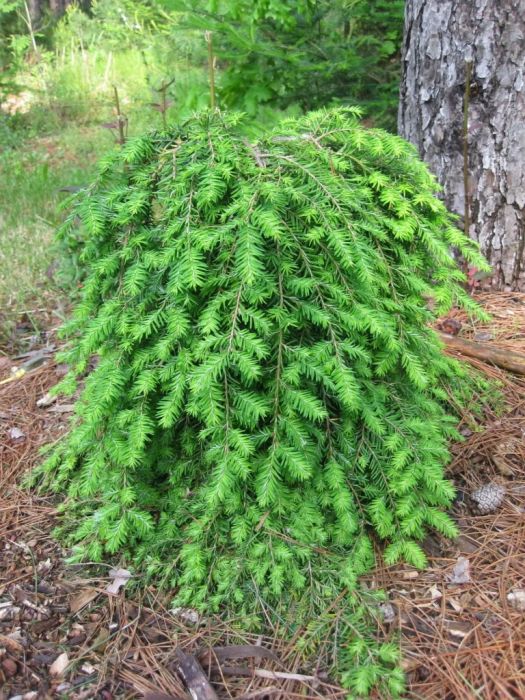Enhance Your Garden With Weeping Plants
You can significantly enhance your garden with weeping plants and Gertens offers many diverse options!



Out of stock
Coming soon, still growingThis plant is a beautiful companion for hostas, rhododendrons, or in a shade garden tumbling over rocks. The stiffly weeping branches ensure that this plant will retain a ground hugging form. Avoid intense winter sun.
Elevate your landscaping with Gertens' unmatched variety of shrubs! Selecting the right shrubs for your backyard can enhance its beauty and functionality. Consider factors like sunlight, soil type, and mature size when choosing shrubs. For sunny areas, flowering shrubs like roses or hydrangeas can add color and charm. In shady spots, opt for shrubs like azaleas or hostas. Evergreen shrubs provide year-round interest and privacy, while deciduous shrubs offer seasonal color changes. At Gertens, we offer a wide selection of shrubs to suit every backyard need.
Cole's Prostrate Canadian Hemlock | Tsuga canadensis 'Cole's Prostrate'
Height: 24 inches
Spread: 4 feet
Sunlight:
Hardiness Zone: 4a
Other Names: Canadian Hemlock, Eastern Hemlock
Brand: Gertens
Description:
A beautiful low growing evergreen garden shrub with dense, cascading branches and a fine textured appearance; excellent for garden detail use; needs organic, acidic soil, adequate moisture and shelter from drying winds
Ornamental Features
Cole's Prostrate Canadian Hemlock is a dwarf conifer which is primarily valued in the garden for its broadly spreading habit of growth. It has dark green evergreen foliage which emerges light green in spring. The needles remain dark green throughout the winter.
Landscape Attributes
Cole's Prostrate Canadian Hemlock is a multi-stemmed evergreen shrub with a ground-hugging habit of growth. It lends an extremely fine and delicate texture to the landscape composition which should be used to full effect.
This shrub will require occasional maintenance and upkeep, and is best pruned in late winter once the threat of extreme cold has passed. Gardeners should be aware of the following characteristic(s) that may warrant special consideration;
Cole's Prostrate Canadian Hemlock is recommended for the following landscape applications;
Planting & Growing
Cole's Prostrate Canadian Hemlock will grow to be about 24 inches tall at maturity, with a spread of 4 feet. It tends to fill out right to the ground and therefore doesn't necessarily require facer plants in front. It grows at a slow rate, and under ideal conditions can be expected to live for 50 years or more.
This shrub performs well in both full sun and full shade. It does best in average to evenly moist conditions, but will not tolerate standing water. It is not particular as to soil type, but has a definite preference for acidic soils. It is quite intolerant of urban pollution, therefore inner city or urban streetside plantings are best avoided, and will benefit from being planted in a relatively sheltered location. Consider applying a thick mulch around the root zone in winter to protect it in exposed locations or colder microclimates. This is a selection of a native North American species.
Cole's Prostrate Canadian Hemlock makes a fine choice for the outdoor landscape, but it is also well-suited for use in outdoor pots and containers. Because of its spreading habit of growth, it is ideally suited for use as a 'spiller' in the 'spiller-thriller-filler' container combination; plant it near the edges where it can spill gracefully over the pot. It is even sizeable enough that it can be grown alone in a suitable container. Note that when grown in a container, it may not perform exactly as indicated on the tag - this is to be expected. Also note that when growing plants in outdoor containers and baskets, they may require more frequent waterings than they would in the yard or garden. Be aware that in our climate, most plants cannot be expected to survive the winter if left in containers outdoors, and this plant is no exception. Contact our experts for more information on how to protect it over the winter months.
| Gerten Grown Plants | Gerten Grown Plants |
|---|---|
| Sun Preference | Full-Sun, Part-Sun, No-Sun |
| Mature Height (Range) | under 2 feet |
| USDA Hardiness Zone | 4, 5, 6, 7, 8 |
| Common Family Name | Hemlock |